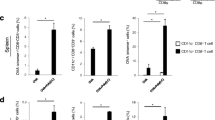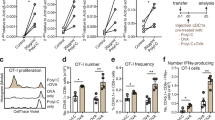Abstract
We reported previously that pigeon cytochrome c-derived peptides (Pan-IA), which bind broad ranges of MHC class II molecules efficiently, activate T helper (Th) function in mice. In an experimental model, Pan-IA DNA vaccines augmented antitumor immunity in tumor antigen-immunized mice. To elicit more potent antitumor immunity and to eradicate tumors in a therapeutic setting, Pan-IA-loaded dendritic cells (DCs) were inoculated in combination with vaccines including ovalbumin (OVA) antigen DNA in tumor-bearing mice. Seventy percent of the immunized mice survived tumor-free for at least 4 months after treatment. In contrast, mice vaccinated with OVA DNA, either with or without naïve DCs, did not eliminate the tumors and died within 5 weeks. Only in mice vaccinated with OVA DNA and Pan-IA-loaded DCs were both cytotoxic and helper responses specific for OVA induced at the spleen and tumor sites as well as at the vaccination sites. Furthermore, accumulation of OVA-specific CD4+ and CD8+ T lymphocytes and interferon-gamma-mediated anti-angiogenesis were observed in the tumors of these mice. Thus, the combined vaccination primed both tumor-specific cytotoxicity and helper immunity resulting in augmented tumor lysis ability and anti-angiogenic effects. This is the first report to show that most established tumors were successfully eradicated by collaboration of potent antitumor immunity and anti-angiogenic effects by vaccination with tumor antigens and helper-activating analogs. This novel vaccination strategy is broadly applicable, regardless of identifying helper epitopes in target molecules, and contributes to the development of therapeutic cancer vaccines.






Similar content being viewed by others
Reference
Qin Z, Richter G, Schuler T, Ibe S, Cao X, Blankenstein T (1998) B cells inhibit induction of T cell-dependent tumor immunity. Nat Med 4:627–630
Ossendorp F, Mengede E, Camps M, Filius R, Melief CJ (1998) Specific T helper cell requirement for optimal induction of cytotoxic T lymphocytes against major histocompatibility complex class II negative tumors. J Exp Med 187:693–702
Fayolle C, Deriaud E, Leclerc C (1991) In vivo induction of cytotoxic T cell response by a free synthetic peptide requires CD4+ T cell help. J Immunol 147:4069–4073
Hart MK, Weinhold KJ, Scearce RM, Washburn EM, Clark CA, Palker TJ, Haynes BF (1991) Priming of anti-human immunodeficiency virus (HIV) CD8+ cytotoxic T cell in vivo by carrier-free HIV synthetic peptide. Proc Natl Acad Sci USA 88:9448–9452
Lasarte JJ, Sarobe P, Gullon A, Prieto J, Borras-Cuesta F (1992) Induction of cytotoxic T lymphocytes in mice against the principal neutralizing domain of HIV-1 by immunization with an engineered T-cytotoxic-T-helper synthetic peptide construct. Cell Immunol 141:211–218
Shirai M, Pendleton CD, Ahler J, Takeshita T, Newman M, Berzofsky JA (1994) Helper-cytotoxic T lymphocyte (CTL) determinant linkage required for priming of anti-HIV CD8+ CTL in vivo with peptide vaccine constructs. J Immunol 152:549–556
Kontani K, Taguchi O, Ozaki Y, Hanaoka J, Tezuka N, Sawai S, Inoue S, Fujino S, Maeda T, Itoh Y, Ogasawara K, Sato H, Ohkubo I, Kudo T (2002) Novel vaccination protocol consisting of injecting MUC1 DNA and nonprimed dendritic cell at the same region greatly enhanced MUC1-specific antitumor immunity in a murine model. Cancer Gene Ther 9:330–337
Teramoto K, Kontani K, Ozaki Y, Sawai S, Tezuka N, Nagata T, Fujino S, Itoh Y, Taguchi O, Koide Y, Asai T, Ohkubo I, Ogasawara K (2003) Deoxyribonucleic acid (DNA) encoding a pan-major histocompatibility complex class II peptide analogue augmented antigen-specific cellular immunity and suppressive effects on tumor growth elicited by DNA vaccine immunotherapy. Cancer Res 63:7920–7925
Minci S, Sturniolo T, Imro MA, Hammer J, Sinigaglia F, Noppen C, Spagnoli G, Mazzi B, Bellone M, Dellabona P, Protti MP (1999) Melanoma cells present a MAGE-3 epitope to CD4(+) cytotoxic T cells in association with histocompatibility leukocyte antigen DR11. J Exp Med 189:753–756
Kobayashi H, Wood M, Song Y, Appella E, Celis E (2000) Defining promiscuous MHC class II helper T-cell epitopes for the HER2/neu tumor antigen. Cancer Res 60:5228–5236
Zarour HM, Maillere B, Brusic V, Coval K, Williams E, Pouvelle-Moratille S, Castelli F, Land S, BennounaJ, Logan T, Kirkwood JM (2002) NY-ESO-1 119–143 is a promiscuous major histocompatibility complex class II T-helper epitope recognized by Th1- and Th2-type tumor reactive CD4+ T cells. Cancer Res 62:213–218
Casares N, Lasarte JJ, Lopez-Diaz de Cerio L, Sarobe P, Ruiz M, Melero I, Prieto J, Borras-Cuesta F (2001) Immunization with a tumor-associated CTL epitope plus a tumor-related or unrelated Th1 helper peptide elicits protective CTL immunity. Eur J Immunol 31:1780–1789
Itoh Y, Ogasawara K, Takami K, Gotohda T, Naruse H, Good RA, Onoe K (1994) Determination of amino acids on agretopes of pigeon cytochrome c-related peptides specifically bound to I-A allelic products. Eur J Immunol 24:76–83
Itoh Y, Kajino K, Ogasawara K, Katoh M, Namba K, Iwabuchi K, Braunstein NS, Onoe K (1996) Determination of the allele-specific antigen-binding site on I-Ak and I-Ab molecules. Eur J Immunol 26:1314–1321
Beatty GL, Paterson Y (2001) IFN-γ-dependent inhibition of tumor angiogenesis by tumor-infiltrating CD4+ T cells requires tumor responsiveness to IFN-γ. J Immunol 166:2276–2282
Qin Z, Schwartzkopff J, Pradera F, Kammertoens, Seliger B, Pircher H, Blankenstein T (2003) A critical requirement of interferon γ-mediated angiogenesis for tumor rejection by CD8+ T cells. Cancer Res 63:4095–4100
Toldbod HE, Agger R, Bolund L, Hokland M (2003) Potent influence of bovine serum proteins in experimental dendritic cell-based vaccination protocol. Scand J Immunol 58:43–50
Ronchese F, Brown MA, Germain RN (1987) Structure-function analysis of the abm 12 beta mutation using site-directed mutagenesis and DNA-mediated gene transfer. J Immunol 139:629–638
Robertson JM, Jensen PE, Evavold BD (2000) DO11.10 and OT-II T cells recognize a c-terminal ovalbumin. J Immunol 164:4706–4712
Passaniti A., Taylor RM, Pili R, Guo Y, Long PV, Haney JA, Pauly RR, Grant DS, Martin GR (1992) A simple quantitative method for assessing angiogenesis and antiangiogenic agents using reconstituted basement membrane, heparin and fibroblast growth factor. Lab Invest 67:519–528
Restifo NP, Spiess PJ, Karp SE, Mule JJ, Rosenberg SA (1992) A nonimmunologenic sarcoma transduced with the cDNA for interferon γ elicits CD8+ T cells against the wild-type tumor: correlation with antigen presentation capability. J Exp Med 175:1423–1431
Paul WE, Seder RA (1996) Lymphocyte responses and cytokines. Cell 1994;76:241–251
Mosmann TR, Sad S (1996) The expanding universe of T-cell subsets: Th1, Th2 and more. Immunol Today 17:138–146
Ridge JP, Rosa FD, Matzinger P (1998) A conditioned dendritic cell can be a temporal bridge between a CD4+ T-helper and a T-killer cell. Nature 393:474–477
Bennett SR, Carbone FR, Karamalis F, Flavell RA, Miller JF, Heath WR (1998) Help for cytotoxic-T-cell responses is mediated by CD40 signaling. Nature 393:478–479
Schoenberger SP, Toes RE, van der Voort EI, Offringa R, Melief CJ (1998) T-cell help for cytotoxic lymphocytes is mediated by CD40-CD40L interaction. Nature 393:480–482
den Haan JM, Bevan MJ (2000) A novel helper role for CD4 T cells. Proc Natl Acad Sci USA 97:12950–12952
Ulmer JB, DeWitt CM, Chastain M, Friedman A, Donnelly JJ, McClements WL, Caulfield MJ, Bohannon KE, Volkin DB, Evans RK (1999) Enhancement of DNA vaccine potency using conventional aluminum adjuvants. Vaccine 8:18–28
Ebhardt MB, Shive CL, Guardia R, Gapin L, Boehm BO, Forsthuber TG (2002) Immunological adjuvants efficiently induce antigen-specific T cell responses in mice: implication for vaccine adjuvant development in aged individuals. Cell Immunol 215:87–97
Rosenberg SA, Yang JC, Schwartzentruber DJ, Hwu P, Marincola FM, Topalian SL, Restifo NP, Schwartz M, Spiess PJ, Wunderlich JR, Seipp CA, Einborn JH, Rogers-Freezer L, White DE (1995) Impact of cytokine administration on the generation of antitumor reactivity in patients with metastatic melanoma receiving a peptide vaccine. J Immunol 163:1690–1695
Tatsumi T, Takehara T, Kanto T, Miyagi T, Kazushita N, Sugimoto Y, Jinushi M, Kasahara A, Sasaki Y, Hori M, Hayashi N (2001) Administration of interleukin-12 enhances the therapeutic efficacy of dendritic cell-based tumor vaccines in mouse hepatocellular carcinoma. Cancer Res 61:7563–7567
Shimizu K, Thomas EK, Giedlin M, Mule JJ (2001) Enhancement of tumor lysate- and peptide-pulsed dendritic cell-based vaccines by the addition of foreign helper protein. Cancer Res 61:2618–2624
Zaliauskiene L, Kang S, Sparks K, Zinn KR, Schwiebert LM, Weaver CT, Lollawn JF (2002) Enhancement of MHC class II-restricted responses by receptor-mediated uptake of peptide antigens. J Immunol 169:2337–2345
Angiolillo AL, Sgadari C, Taub DD, Liao F, Faber JM, Maheshwari S, Kleinman HK, Reaman GH, Tosato G (1995) Human interferon-inducible protein 10 is a potent inhibitor of angiogenesis in vivo. J Exp Med 182:155–162
Arenberg DA, Kunkel SL, Polverini PJ, Morris SB, Burdick MD, Glass MC, Taub DT, Iannettoni MD, Whyte RI, Strieter RM (1996) Interferon-γ-inducible protein 10 (IP-10) is an angiostatic factor that inhibits human non-small cell lung cancer (NSCLC) tumorigenesis and spontaneous metastasis. J Exp Med 184:981–992
Sgadari C, Farber JM, Angiolillo AL, Liao F, Teryua-Feldstein J, Burd PR, Yao L, Gupta G, Kanegane C, Tosato G (1997) Mig, the monokine induced by interferon-γ promotes tumor necrosis in vivo. Blood 89:2635–2643
Strieter RM, Polverini PJ, Arenberg DA, Kunkel SL (1995) The role of CXC chemokine as regulators of angiogenesis. Shock 4:155–160
Acknowledgment
This study was supported in part by grant-in-aid for scientific research from the Ministry of Education, Science, Sports and Culture, Japan (Nos. 13671380, 14571262, 15591340, and 16591392) and grant from YASUDA Medical Research Foundation.
Author information
Authors and Affiliations
Corresponding author
Rights and permissions
About this article
Cite this article
Teramoto, K., Kontani, K., Fujita, T. et al. Successful tumor eradication was achieved by collaboration of augmented cytotoxic activity and anti-angiogenic effects following therapeutic vaccines containing helper-activating analog-loaded dendritic cells and tumor antigen DNA. Cancer Immunol Immunother 56, 331–342 (2007). https://doi.org/10.1007/s00262-006-0192-0
Received:
Accepted:
Published:
Issue Date:
DOI: https://doi.org/10.1007/s00262-006-0192-0




